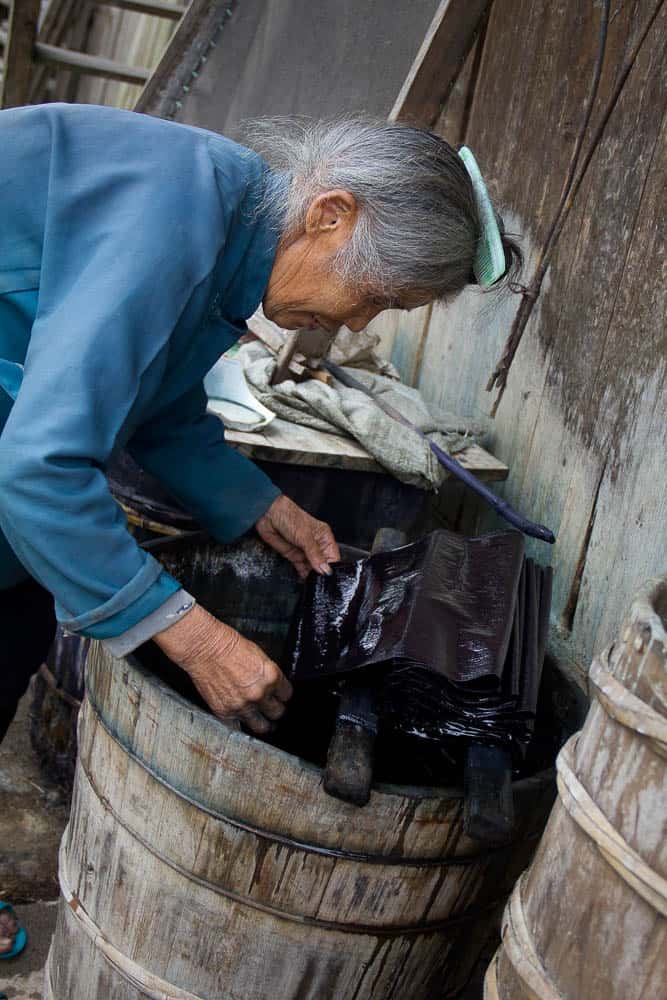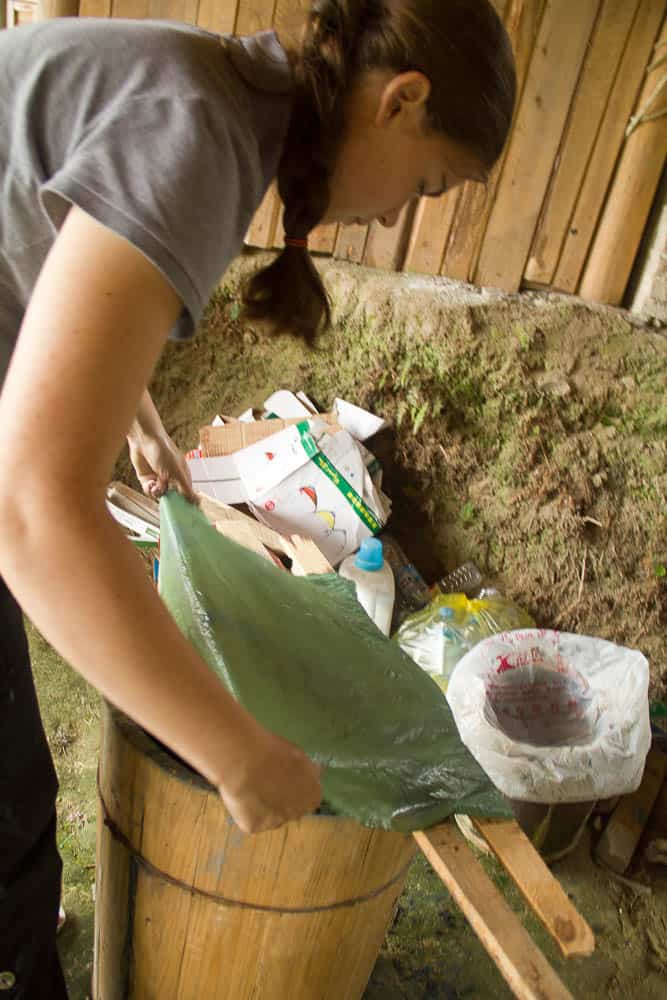The book Kam Women Artisans of China: Dawn of the Butterflies celebrates the knowledge of five elderly women from the Kam/Dong minority who live in Dimen village, Guizhou province in China. The women, each with a unique story, share their distinctive artistic skills and the knowledge of their ancestors in the hope it will not be forgotten by future generations. With great patience, they reveal hidden techniques behind their crafts in a series of lively lessons given to the author and her students.
Kam women make all the fabric used to dress their families. They weave the traditional Kam cloth on a frame loom that is somewhat different from looms used elsewhere. The preparation of the thread and the loom is also unlike any other. The cloth is dyed multiple times in indigo and red dye made from dyeing yam and azalea. It is then starched, treated with ox skin glue, and beaten for shine. Shimmering in the light with midnight blues and red purples, the cloth is stiff, strong, and surprisingly durable. We present a selection from Chapter 11: Dyeing in Indigo where the author and her student Anastasya Uskov replicate the dyeing process of the Kam artisans and present their results to the artisans.
My Blues of the Blues
- Wu Meitz Dyes Cloth in Indigo Vat.
- Wu Meitz Washes Cloth In River
- Hanging Almost Finished Indigo-Dyed Cloth
- Lee Holds Wet Fabric Before It is Dyed
- Anastasya Dyes Cloth in Indogo
- Machine Made Cloth Just Taken Out Of Indigo Dye For the First Time
- Lee Takes Out Fabric From Indigo Vat
- Fabric Oxidizes at the Bottom Turning Blue
- Machine Made Cloth Dyed By Author
- Butterfly On Indigo Vat
We dye in our vat, unassisted / July 27– 31, 2011
I have already dyed my Kam fabric in indigo this morning, and it is drying at Wu Meitz’s workshop. My pleated skirt is soaking wet with red dye and drying in the museum courtyard. It is time to try the vat we have prepared with our teachers at the start of our trip. Anastasya makes a drying rack from two narrow planks of wood laid on top of the vat while I bring a few pieces of machine-made cotton muslin I have brought with me from the States.
We wet two pieces of cloth in hot water for five minutes and put it in the vat for five minutes. Anastasya gets the honour of taking the cloth out first while I document the transformation. She is pulling the cloth bit by bit and folding it on the drying rack like an accordion. The cloth is much wider than Kam cloth so it is harder to fold neatly and some of the liquid drips on the ground.
The cloth comes out light green but immediately starts turning blue. We have seen the same transformation when dyeing the handwoven Kam cloth before, but it still feels like magic. We savour the moment. We have waited for it for more than a year. There were times I lost hope of learning to make a Kam indigo vat and dyeing in it.
After the cloth oxidises for five minutes, I feed it back into the vat and fetch the other cloth floating in there. I take that one out in its entirety to see the transformation on a large scale. The dye has adhered to the cloth unevenly. It was probably just floating on the top while it should have been submerged under the surface. I fold the cloth now, let it oxidize and submerge it again.
We alternate dyeing the cloths until each has been through five cycles of five minutes in the vat and five minutes out. An hour and twenty minutes later, we hang the cloths to dry. The light blue colour is still uneven. We manage to repeat the entire cycle two more times today. The blue is quite deep and even by the evening. I cut off a swatch from the fabric after every cycle to record the dyeing progression.
I really like the blue we have achieved after three cycles so I swap one of the pieces for a new fabric I brought with me. It is machine-made linen, not cotton. I take the cotton fabric from yesterday and the linen through another dyeing cycle. The linen dyes more evenly than the cotton did at first. I squeeze another series in between other work the next day and another two days later.
An orange butterfly rests on the vat as I wait for the cloth to oxidise on the drying rack. The linen cloth is now a gorgeous blue shade so I put it away and keep dyeing the cotton one. It shows streaks of black after the series of eight. I then starch it and dye it twice in red. The result is pitch black stiff cloth. It is slightly wrinkled because I did not manage to steam it. I will iron it when I get home.
I proudly take the cloth to show my teachers. I am hoping to maybe sew something out of it since I have used up the whole Kam cloth to make an apron, a coat, and calf wraps. The women are all chatting at Wu Mnci’s porch. They examine the cloth with a slight frown as they pass it around.
“Not a good quality, see!” Wu Mnci rips the cloth. “A fabric should be much stronger. It should not rip this easily.”
After I recover from the shock of having my precious cloth violated, I must admit that she is right. It is a machine-made cloth, and it can in no way compete with the strength of Kam handwoven cloth. The threads were strengthened in alkali before they were woven. Then, indigo and red dye, starching, ox glue, and beating reinforced them. The result is a fabric that is so stiff and hard it stands on its own. When folded, the crease remains sharp and will not go away.
It has been almost three weeks since we started our vat and a week since I started dyeing in it. My fabrics were short so they did not take much time to dye, and they were thin, so they dried quickly. I did not have a household to run and fields to take care of. I had also help from many hands. I am taking away an armful of knowledge besides the three fabrics I dyed to my taste. Someone use my vat when I am gone, please! There is a treasure inside!
This is an edited selection from Chapter 11: Dyeing in Indigo, section 11.5 My Blues of the Blues (Kam Women Artisans of China: Dawn of the Butterflies, pages 158–160). Singing Hands Cooperative, Dimen Village China and University of the Pacific, USA
Postscript
Since the publication of the book, Marie Anna Lee, her students and the artisans have formed a fair-trade cooperative called Singing Hands to give the artisans a sustainable income and support the Dimen community with its profits. They design contemporary products based on Kam aesthetics and processes described in the book. They reshape traditional elements into new products like bookmarks and keychains. They make bags out of their indigo-dyed cloth and screen print traditional motifs on them. Lee and her students have developed product prototypes and created guides for the artisans. The artisans then develop the actual products based on the prototypes and produce them. Students help artisans order materials not found locally, teach time-saving processes like screen printing, and market the products on their campus, in their community and online. There are three generations of women working at the cooperative now. The earnings give the young women a compelling reason to learn their culture and traditional crafts. They can also work from home and do not have to leave their children behind to earn living in distant factories. All profits go into community projects of the artisans’ choosing. Visit their online store at singinghands.org.
Author
 Marie Anna Lee is an associate professor of art at the University of the Pacific in Stockton, California. She has worked on the cultural preservation of Kam indigenous heritage since 2007. She received the 2013 and 2014 SEED (Social Environmental Economic Design) Award Honourable Mention for Excellence in Public Interest Design for her work in Dimen. As part of the Kam delegation from Dimen, Lee presented at the Smithsonian Folklife Festival in Washington, D.C. in 2014. She taught at Public Interest Design Institute in Denver in 2013 and presented her research at numerous national and international conferences. Her photographs from Dimen will be exhibited at the Náprstek Museum, part of the Czech National Museum, in Prague in the fall of 2019. She has exhibited her art in the USA, China, and the Czech Republic. Lee holds a BFA and an MFA in Graphic Design from Colorado State University and a BA in Advertising from Michigan State University. She was born in Prague, Czech Republic.
Marie Anna Lee is an associate professor of art at the University of the Pacific in Stockton, California. She has worked on the cultural preservation of Kam indigenous heritage since 2007. She received the 2013 and 2014 SEED (Social Environmental Economic Design) Award Honourable Mention for Excellence in Public Interest Design for her work in Dimen. As part of the Kam delegation from Dimen, Lee presented at the Smithsonian Folklife Festival in Washington, D.C. in 2014. She taught at Public Interest Design Institute in Denver in 2013 and presented her research at numerous national and international conferences. Her photographs from Dimen will be exhibited at the Náprstek Museum, part of the Czech National Museum, in Prague in the fall of 2019. She has exhibited her art in the USA, China, and the Czech Republic. Lee holds a BFA and an MFA in Graphic Design from Colorado State University and a BA in Advertising from Michigan State University. She was born in Prague, Czech Republic.













Comments
First kam woman make the whole fabric used to dress there families .Next they begin to dye there families dress with blue dye .Then they dress there family’s and make them dance and do all that tradition stofe Last they make there ansectors proud dance and sing